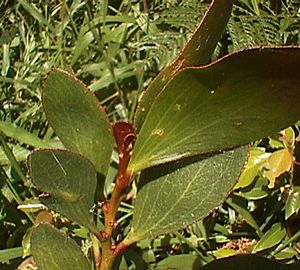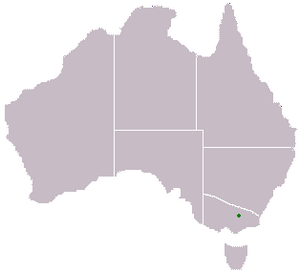Acacia phlebophylla facts for kids
Quick facts for kids Acacia phlebophylla |
|
|---|---|
 |
|
| Scientific classification | |
| Genus: |
Acacia
|
| Species: |
phlebophylla
|
 |
|
| Range of Acacia phlebophylla | |
| Synonyms | |
Acacia phlebophylla, also known as the Buffalo sallow wattle or Mount Buffalo wattle, is a special type of acacia plant. It grows as a sprawling shrub or a small, twisted tree, reaching up to 5 meters (about 16 feet) tall. This plant is a close relative of another acacia called Acacia alpina.
Contents
What Does It Look Like?
This acacia has large, flat, and often uneven leaves called phyllodes. These phyllodes are usually 4–14 centimeters (1.5–5.5 inches) long and 1.5–6 centimeters (0.6–2.4 inches) wide. They feel leathery and have strong, clear veins.
In spring (June to December in Australia), deep yellow, rod-shaped flowers appear. These flowers are spread out on spikes that are 4–7 centimeters (1.5–2.7 inches) long. After the flowers, long, narrow seed pods (called legumes) grow from November to March. These pods are 7–10 centimeters (2.7–3.9 inches) long and hold 5–10 oval-shaped seeds, each about 5–7.5 millimeters (0.2–0.3 inches) long.
Where Does It Grow?
Acacia phlebophylla is only found in one specific place: the high-altitude granite slopes of Mount Buffalo National Park in Victoria, Australia. It grows above 350 meters (about 1,150 feet) in woodlands and heathlands, often among large granite rocks.
Why Is It Important to Protect It?
This plant is considered rare and threatened by the Victoria Department of Sustainability and Environment. There is only one main group of these plants left in the wild.
- Over the years, this group has been damaged by bushfires and fungal infections.
- Scientists are worried about the future of this plant, especially because of the threat from plant diseases caused by pathogens (like fungi). A certain type of local wasp might even help spread this fungal disease.
- To help protect the plants, people are strongly advised not to walk among them from one plant group to another. This helps prevent the spread of the fungal disease, which is currently their biggest threat.
Can It Grow Elsewhere?
Interestingly, healthy Acacia phlebophylla plants are growing in private gardens in places like Gatton, Queensland and near Meadows in South Australia, as well as in Ireland. This shows that the plant might not be as difficult to grow outside its natural mountain home as people once thought.

